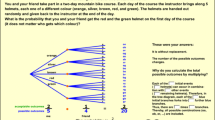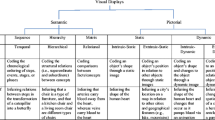Abstract
Visual displays, such as illustrated web pages, animations, and simulations, can both aid and pose challenges for learners. The first generation of educational research on visuals focused on the basic processes underlying comprehension. A second generation of research tested various instructional supports for visual displays, and this research was summarized by Renkl and Scheiter (2017). The authors of the present article summarize those earlier findings and update the state of the literature to the present day. Trends in more recent findings partially support the recommendations from the previous review, but suggest that much nuance is needed to understand on what learning outcomes, for whom, with what learning content, which technology, and other factors, visual display supports are effective.
Similar content being viewed by others
References
Arslan-Ari, I. (2018). Learning from instructional animations: How does prior knowledge mediate the effect of visual cues? Journal of Computer Assisted Learning, 34(2), 140–149. https://doi.org/10.1111/jcal.12222.
Bergey, B. W., Cromley, J. G., Kirchgessner, A., & Newcombe, N. (2015a). Using diagrams versus text for spaced restudy: Effects on learning in 10th grade biology classes. British Journal of Educational Psychology, 85, 57–94. https://doi.org/10.1111/bjep.12062.
Bergey, B. W., Cromley, J. G., & Newcombe, N. (2015b). Teaching high school biology students to coordinate text and diagrams: Relations with transfer, effort, and spatial skill. International Journal of Science Education, 37(15), 2476–2502. https://doi.org/10.1080/09500693.2015.1082672.
Biard, N., Cojean, S., & Jamet, E. (2018). Effects of segmentation and pacing on procedural learning by video. Computers in Human Behavior, 89, 411–417. https://doi.org/10.1016/j.chb.2017.12.002.
Clinton-Lisell, V. (2022). Listening ears or reading eyes: A meta-analysis of reading and listening comprehension comparisons. Review of Educational Research, 92(4), 543–582.
Coleman, J. M., McTigue, E. M., & Dantzler, J. A. (2018). What makes a diagram easy or hard? The impact of diagram design on fourth-grade students’ comprehension of science texts. The Elementary School Journal, 119(1), 122–151.
Cromley, J. G., Chen, R., & Lawrence, L. (2023). Meta-analysis of STEM learning using virtual reality: Benefits across the board. Journal of Science Education and Technology, 32(3), 355–364. https://doi.org/10.1007/s10956-023-10032-5.
Cromley, J. G., Weisberg, S. M., Dai, T., Newcombe, N. S., Schunn, C. D., Massey, C., & Merlino, F. J. (2016). Improving middle school science learning using diagrammatic reasoning. Science Education, 100(6), 1184–1213. https://doi.org/10.1002/sce.21241.
de Koning, B. B., Rop, G., & Paas, F. (2020). Learning from split-attention materials: Effects of teaching physical and mental learning strategies. Contemporary Educational Psychology, 61, 101873.
Fiorella, L., & Pilegard, C. (2021). Learner-generated explanations: Effects on restudying and learning from a multimedia lesson. Educational Psychology, 41(1), 45–62.
Fiorella, L., Kuhlmann, S., & Vogel-Walcutt, J. J. (2019). Effects of playing an educational math game that incorporates learning by teaching. Journal of Educational Computing Research, 57(6), 1495–1512.
Glaser, M., & Schwan, S. (2020). Combining verbal and visual cueing: Fostering learning pictorial content by coordinating verbal explanations with different types of visual cueing. Instructional Science, 48, 159–182. https://doi.org/10.1007/s11251-020-09506-5.
Hefter, M. H., ten Hagen, I., Krense, C., Berthold, K., & Renkl, A. (2019). Effective and efficient acquisition of argumentation knowledge by self-explaining examples: Videos, texts, or graphic novels? Journal of Educational Psychology, 111(8), 1396–1405.
Hoch, E., Scheiter, K., & Schüler, A. (2020a). Implementation intentions for improving self-regulation in multimedia learning: Why don’t they work? The Journal of Experimental Education, 88(4), 536–558.
Hoch, E., Scheiter, K., & Schüler, A. (2020b). Implementation intentions related to self-regulatory processes do not enhance learning in a multimedia environment. Frontiers in Psychology, 11(46), https://doi.org/10.3389/fpsyg.2020.00046.
Hoch, E., Scheiter, K., & Stalbovs, K. (2023). How to support learning with multimedia instruction: Implementation intentions help even when load is high. British Journal of Psychology. https://doi.org/10.1111/bjop.12620.
Jian, Y. C. (2021). The immediate and delayed effects of text–diagram reading instruction on reading comprehension and learning processes: Evidence from eye movements. Reading and Writing, 34(3), 727–752.
Joo, H., Park, J., & Kim, D. (2021). Visual representation fidelity and self-explanation prompts in multi‐representational adaptive learning. Journal of Computer Assisted Learning, 37(4), 1091–1106.
Kollmer, J., Hosp, T., Glogger-Frey, I., Renkl, A., & Eitel, A. (2021). Adjunct Aids and signals support online learning from multiple representations. Journal of Computer Assisted Learning, 37(1), 172–182.
Krieglstein, F., Schneider, S., Gröninger, J., Beege, M., Nebel, S., Wesenberg, L., & Rey, G. D. (2023). Exploring the effects of content-related segmentations and metacognitive prompts on learning with whiteboard animations. Computers & Education, 194, 104702. https://doi.org/10.1016/j.compedu.2022.104702.
Kühl, T. (2021). Prerequisite knowledge and time of testing in learning with animations and static pictures: Evidence for the expertise reversal effect. Learning and Instruction, 73, 101457.
Kühl, T., Navratil, S. D., & Münzer, S. (2018). Animations and static pictures: The influence of prompting and time of testing. Learning and Instruction, 58, 201–209.
Lin, Y. C., Liu, T. C., & Kalyuga, S. (2022). Strategies for facilitating processing of transient information in instructional videos by using learner control mechanisms. Instructional Science, 50, 863–877.
Miller, B. W., Cromley, J. G., & Newcombe, N. S. (2016). Improving diagrammatic reasoning in middle school science using conventions of diagrams instruction delivered in electronic warm-ups. Journal of Computer Assisted Learning, 32(4), 374–390. https://doi.org/10.1111/jcal.12143.
Renkl, A., & Scheiter, K. (2017). Studying visual displays: How to instructionally support learning. Educational Psychology Review, 29(3), 599–621.
Richter, J., & Scheiter, K. (2019). Studying the expertise reversal of the multimedia signaling effect at a process level: Evidence from eye tracking. Instructional Science, 47(6), 627–658.
Richter, J., Scheiter, K., & Eitel, A. (2018). Signaling text–picture relations in multimedia learning: The influence of prior knowledge. Journal of Educational Psychology, 110(4), 544–560.
Ring, M., Brahm, T., Richter, J., Scheiter, K., & Randler, C. (2022). Does active or passive signaling support integration of text and graphs? Applied Cognitive Psychology, 36(1), 43–58.
Scheiter, K., Schubert, C., Schüler, A., Schmidt, H., Zimmermann, G., Wassermann, B., & Eder, T. (2019). Adaptive multimedia: Using gaze-contingent instructional guidance to provide personalized processing support. Computers & Education, 139, 31–47.
Scheiter, K., Brucker, B., & Ainsworth, S. (2020). Now move like that fish: Can enactment help learners come to understand dynamic motion presented in photographs and videos? Computers & Education, 155, 103934.
Schunn, C. D., Newcombe, N. S., Alfieri, L., Cromley, J. G., Massey, C., & Merlino, F. J. (2018). Using principles of cognitive science to improve science learning in middle school: What works when and for whom? Applied Cognitive Psychology, 32(2), 225–240. https://doi.org/10.1002/acp.3398.
Seufert, T. (2019). Training for coherence formation when learning from text and picture and the interplay with learners’ prior knowledge. Frontiers in Psychology, 10, 193.
Skulmowski, A. (2022). Is there an optimum of realism in computer-generated instructional visualizations? Education and Information Technologies, 27(7), 10309–10326.
Skulmowski, A. (2023). Realistic details impact learners independently of split-attention effects. Cognitive Processing, 1–12. https://doi.org/10.1007/s10339-022-01123-z.
Skulmowski, A., & Rey, G. D. (2018). Realistic details in visualizations require color cues to foster retention. Computers & Education, 122, 23–31.
Skulmowski, A., & Rey, G. D. (2020). The realism paradox: Realism can act as a form of signaling despite being associated with cognitive load. Human Behavior and Emerging Technologies, 2(3), 251–258.
Sundararajan, N., & Adesope, O. (2020). Keep it coherent: A meta-analysis of the seductive details effect. Educational Psychology Review, 32(3), 707–734.
Tatum, C., & Dickason, D. (2021). Search processes in the exploration of complex data under different display conditions. Journal of Data Analysis and Information Processing, 9(02), 51–62.
van der Graaf, J., Segers, E., & de Jong, T. (2020). Fostering integration of informational texts and virtual labs during inquiry-based learning. Contemporary Educational Psychology, 62, 101890.
Xie, H., Mayer, R. E., Wang, F., & Zhou, Z. (2019). Coordinating visual and auditory cueing in multimedia learning. Journal of Educational Psychology, 111(2), 235. https://doi.org/10.1037/edu0000285.
Yang, H. Y. (2022). Effects of visuospatial cues on instructional static and dynamic visualizations on learner mental model constructions. International Journal of Technology and Human Interaction (IJTHI), 18(1), 1–15.
Yang, C., Jen, C. H., Chang, C. Y., & Yeh, T. K. (2018). Comparison of animation and static-picture based instruction: Effects on performance and cognitive load for learning genetics. Journal of Educational Technology & Society, 21(4), 1–11. http://www.jstor.org/stable/26511533.
Funding
The research reported here was supported by the Institute of Education Sciences, U.S. Department of Education, through Grant R305A220015 to Texas A&M University. The opinions expressed are those of the authors and do not represent views of the Institute or the U.S. Department of Education.
Author information
Authors and Affiliations
Corresponding author
Ethics declarations
Conflict of Interest
The authors know of no conflicts of interest related to this manuscript. The funder had no say in the contents or findings related to this manuscript.
Additional information
Publisher’s Note
Springer Nature remains neutral with regard to jurisdictional claims in published maps and institutional affiliations.
Rights and permissions
Springer Nature or its licensor (e.g. a society or other partner) holds exclusive rights to this article under a publishing agreement with the author(s) or other rightsholder(s); author self-archiving of the accepted manuscript version of this article is solely governed by the terms of such publishing agreement and applicable law.
About this article
Cite this article
Cromley, J.G., Chen, R. Instructional Support for Visual Displays: An Updated Literature Review. Tech Know Learn (2023). https://doi.org/10.1007/s10758-023-09699-x
Accepted:
Published:
DOI: https://doi.org/10.1007/s10758-023-09699-x




